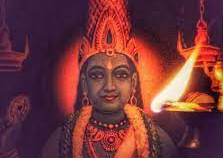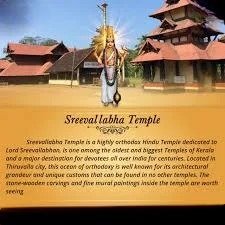Sreevallabha Temple
The Sreevallabha Temple is a highly orthodox Hindu temple dedicated to Sreevallabha, a form of Vishnu.It is one of the oldest and biggest Temples of Kerala and has been a major destination for devotees all over India for centuries. Located in Thiruvalla city, this temple is well known for its architectural grandeur and unique customs which can be found in no other temples. There are stone-wooden carvings and mural paintings inside the temple. Being one among 108 Divya Desams,Sreevallabha temple has been glorified by Alvars and many other ancient works. It is considered to be the vallabha kshethram mentioned in Garuda Purana and Matsya Purana.Kathakali is played daily in the temple as an offering, pushing it to the top in India in terms of places where Kathakali is staged on the largest number of days per year.Vishnu appeared here as Sreevallabha for sage Durvasa and Khandakarnan.Pleased by the prayers of an old Brahmin lady Sreevallabha incarnated as a Brahmachari and killed the demon Thokalaasuran. Later the deity of Sreevallabha worshipped by Lakshmi and Krishna was installed in the temple in 59 BC. From then till date, the temple follows its worship protocol that is known to be followed nowhere else yet. Sage Durvasa and Saptarishi are said to reach the temple every midnight for worshipping the Lord. The temple governed one of the biggest educational institutions in ancient times and heavily contributed to the cultural and educational developments of Kerala.
Access
Situated 750 meters south to Ramapuram vegetable market and 500 metres south to Kavumbhagom junction on Thiruvalla–Ambalappuzha state highway (SH-12), Sreevallabha temple is just 2.5 km away from Thiruvalla railway station and 2 km from KSRTC bus stand. Both KSRTC and private bus services are available frequently. Auto-taxi services are also available.
Temple administration
The temple is under administration of Travancore Devaswom Board and is a major temple under Thiruvalla group.
History
Present Thiruvalla was once a village among 64 Namboothiri villages in Kerala and is one of the oldest human settlements in India. Since this place is situated at the mouth (vai) of Manimala River (valla river) it had been known as ‘vallavai’ and later transformed into ‘thiruvalla’.Historical evidences point out the place had been inhabited by humans before 3000 BC. The Thiruvalla inscriptions say the temple for Sudarshana Chakra was built in 2998 BC .Another opinion is that the place was named after sreevallabha temple as sreevallabhapuram and Thiruvalla in colloquial Malayalam.The temple for Sudarshana Chakra was built by Sreedevi Antherjanam of Sankramangalathu Illam and it was elaborately rebuilt by Queen Cherumthevi in 59 BC.Sreevallabha temple flourished to a major spiritual and educational centre by CE 1100. The temple had governed a Vedic school (thiruvalla sala)with around 1500 students and 150 teachers. Veda, Vedanta, Tarka, Mimamsa, Jyotisha, Ayurveda, and Kalaripayattu were taught there. The temple also owned an ayurvedic hospital with facilities to admit and treat 100 patients at a time. Addressing Vishnu by names Kolapiran, Thiruvazhmarvan and Sundarayan, the Tamil vaishnavite saints Nammalvar of the 5th century CE (2612-2622 in Divya Prabhandham) and Thirumangai Alvar of the 9th century CE (paasurams 1806-1817 in Divya prabhandham) had praised glory of the temple.Famous Sanskrit poet Daṇḍin (7th century CE) of Kanchi mentioned the temple in his works. The first ever prose work in Malayalam is the Thiruvalla inscriptions dated to the first half of the 12th century CE, which was obtained from the temple during 1915. The Unnuneeli Sandesam of the 13th century CE highlighted the grandeur, beauty, serenity, fame and status of the temple during its time.
Other works that glorified the temple are Sreevallabha Ksethra Mahathmyam of the 10th century CE, Sreevallabha Charitham kavyam, Thukalasura Vadham Kathakali, Sreevallabha Charitham Kathakali, Sreevallabha Vijayam Kathakali, Sreevallabha Suprabhatham, Sreevallabha Karnamritha Sthothram, Yajanavali Sangrham etc.
From the date built, the temple was under control of thiruvalla pattillathil pottimar (Brahmins of ten families) till 1752-1753. Sreevallabha Temple emerged as a major spiritual destination for devotees all over India centuries before. It had 15 major priests (melsanthi) and 180 sub-ordinate priests (keezhsanthi) all the time and another 108 for only daily noon pooja. Temple provided staying and food facilities for all visitors, students, teachers etc. and also used to conduct annadanam (serving food to the poor) daily. Naivedyam of Sreevallabha for a single time used to be made from 45 para (one para can feed appx 100 persons) rice. In all these years, temple acquired enormous amount of wealth that it even used to serve food in golden banana leaves and throw them as the leavings. It also had thousands of acres of land too which are lost now. During 1752-1753 Marthanda Varma of Travancore captured the temple from Pathillathil Pottimar Up to 1968, ladies and elephants were not allowed in the temple. The temple used to be opened for ladies only during Thiruvathira of dhanu month and Vishu of medam till then. Any how now this custom is not in practise. These facts clearly show how popular and wealthy the temple was then.

















